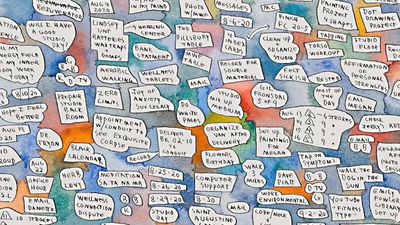For This Artist, Documenting the Process of Making Art Is Art Unto Itself
“I HAVE ALWAYS used my life as a way of making art,” says Texas-based septuagenarian artist Vincent Falsetta, who is well known for documenting the creation of each of his paintings with a series of notecards, each of which are arguably a work of art in itself.
But the lines between documentation and a visionary practice are even blurrier in Falsetta’s new show, Dynamic Duality, a collection of paintings and drawings on view at Anya Tish Gallery through May 7. The show’s title may refer to the spontaneous, almost explosive nature of his art verses the intensive, monkish labor required to get it down on the canvas or paper.
Falsetta’s medium-size “text” drawings-slash-paintings are especially dynamic. Like a two-dimensional realization of the scene in The Berlin State Library in Wim Wenders’ 1987 film Wings of Desire — in which the collective inner thoughts of the library’s readers and researchers, both young and old, become a part of the soundtrack — each drawing is filled with cartoonish “thought bubbles,” consisting of mostly dull, matter-of-fact statements you’d scribble in a daily planner.
'FG 21-1'
'21-1'
The bubbles and words are drawn with great care, using a quill pen and India ink, after which watercolor was added inch-by-inch, filling the negative space between the texts. The fact that these works were conceived during the pandemic is relevant, as the stress of that time, and how vulnerable it made us feel, was very much on Falsetta’s mind. “What I’m trying to do is recognize that vulnerability, and make something beautiful about the vulnerability,” says Falsetta. “The personalization of these text drawings may reflect the human condition in some weird way.” The attentive viewer will notice some not-so-dull statements sprinkled throughout these works (NOT FEELING WELL, SMILE, TRY BEING AWARE OF BREATHING)which speak to the thin line between mental inertia and physical action.
Seemingly at the other end of the spectrum are Falsetta’s much larger abstract oil paintings, which are filled with motion, although that motion doesn’t feel nervous or foreboding. Looking at these paintings is like seeing the music of the spheres and inspires a stillness in the viewer as they reveal layer after layer of otherworldly colors, microscopic textures and the artist’s own internalized rhythm.
- Houston Artist Hangs Funky New Works That Are Anything But ... ›
- 'Selfie with Godzilla'?! Artist Fuses Reality and Science Fiction in ... ›
- Army Propagandist Turned Climate Champ HJ Bott, a Math-Minded ... ›
- Inspired by the ‘Ordinary,’ Lillian Warren’s Paintings Are Anything But - Houston CityBook ›
- Provocative Pop-Up Show Transforms Montrose Gallery for Two Weeks - Houston CityBook ›
